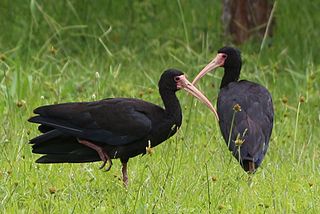
Ovenbirds or furnariids are a large family of small suboscine passerine birds found from Mexico and Central to southern South America. They form the family Furnariidae. This is a large family containing around 315 species and 70 genera. The ovenbird, which breeds in North America, is not a furnariid – rather it is a distantly related bird of the wood warbler family, Parulidae.

The Iguanidae is a family of lizards composed of the iguanas, chuckwallas, and their prehistoric relatives, including the widespread green iguana.

The Dytiscidae – based on the Greek dytikos (δυτικός), "able to dive" – are the predaceous diving beetles, a family of water beetles. They occur in virtually any freshwater habitat around the world, but a few species live among leaf litter. The adults of most are between 1 and 2.5 cm (0.4–1.0 in) long, though much variation is seen between species. The European Dytiscus latissimus and Brazilian Megadytes ducalis are the largest, reaching up to 4.5 cm (1.8 in) and 4.75 cm (1.9 in) respectively. In contrast, the smallest is likely the Australian Limbodessus atypicali of subterranean waters, which only is about 0.9 mm (0.035 in) long. Most are dark brown, blackish, or dark olive in color with golden highlights in some subfamilies. The larvae are commonly known as water tigers due to their voracious appetite. They have short, but sharp mandibles and immediately upon biting, they deliver digestive enzymes into prey to suck their liquefied remains. The family includes more than 4,000 described species in numerous genera.

Corydoras is a genus of freshwater catfish in the family Callichthyidae and subfamily Corydoradinae. The species usually have more restricted areas of endemism than other callichthyids, but the area of distribution of the entire genus almost equals the area of distribution of the family, except for Panama where Corydoras is not present. Corydoras species are distributed in South America where they can be found from the east of the Andes to the Atlantic coast, from Trinidad to the Río de la Plata drainage in northern Argentina. Species assigned to Corydoras display a broad diversity of body shapes and coloration. Corydoras are small fish, ranging from 2.5 to 12 cm in SL., and are protected from predators by their body armor and by their sharp, typically venomous spines.

The Neotropical pygmy squirrel is a South American species of tree squirrel, being the only living species in the genus Sciurillus and the subfamily Sciurillinae. Genetic analysis has shown it to be the sister group to all other squirrels.

The Neotropical fruit bats (Artibeus) are a genus of bats within the subfamily Stenodermatinae. The genus consists of 12 species, which are native to Central and South America, as well as the Caribbean.

The sharp-tailed ibis is a species of ibis native to open wet savannas in parts of northern South America.

Megadytes is a genus of diving beetles in the family Dytiscidae. They are found in slow-moving or static freshwater habitats in the Neotropics. The adult beetles measure about 1.65–4.75 cm (0.6–1.9 in) long depending on the exact species and the largest is also the largest in the family.

The minute tree-fungus beetles, family Ciidae, are a sizeable group of beetles which inhabit Polyporales bracket fungi or coarse woody debris. Most numerous in warmer regions, they are nonetheless widespread and a considerable number of species occur as far polewards as Scandinavia for example.

Cybister, is a genus of beetle in family Dytiscidae. They are found in much of the world, including all continents except Antarctica. As of 2021 there are 96 species and 9 additional subspecies among four subgenera in the genus.

Bifurcitus lherminieri, formerly Megadytes lherminieri, is a species in the genus Bifurcitus of large diving beetles found in the Neotropics.
Queda is a genus of predaceous diving beetles in the family Dytiscidae. There are at least three described species in Queda, found in the Neotropics.

The Solanaceae, or the nightshades, are a family of flowering plants that ranges from annual and perennial herbs to vines, lianas, epiphytes, shrubs, and trees, and includes a number of agricultural crops, medicinal plants, spices, weeds, and ornamentals. Many members of the family contain potent alkaloids, and some are highly toxic, but many—including tomatoes, potatoes, eggplant, bell, and chili peppers—are used as food. The family belongs to the order Solanales, in the asterid group and class Magnoliopsida (dicotyledons). The Solanaceae consists of about 98 genera and some 2,700 species, with a great diversity of habitats, morphology and ecology.

Thomas's big-eared brown bat is a species of vesper bat found in South America.

Cybistrini is a tribe of predaceous diving beetles in the family Dytiscidae. There are 12 genera and 130 described extant species in Cybistrini. The same set is also called Cybistrinae by authors viewing it as a subfamily of Dytiscidae.
Bifurcitus magnus is a species of beetles in the dytiscid subfamily Cybistrinae that occurs in South America.
Metaxydytes is a genus of beetles in the dytiscid subfamily Cybistrinae that occur in the Neotropics. The genus contains nine species; they were previously classified in the genus Megadytes.
Paramegadytes is a genus of beetles in the dytiscid subfamily Cybistrinae that occur in the Neotropics. The genus contains two species that were previously classified in the genus Megadytes.
Trifurcitus is a genus of beetles in the dytiscid subfamily Cybistrinae that occur in the Neotropics. The genus contains six species that were previously classified in the genus Megadytes.
Nilssondytes is a genus of predaceous diving beetles in the family Dytiscidae. Following reclassification of the subfamily Cybistrinae in 2024, only a single species, N. diversus, is included in the genus.













